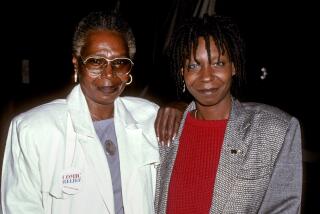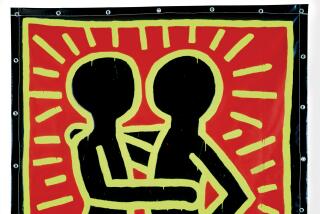Artist Walter Gabrielson dies at 73
Walter Gabrielson, an artist, teacher and writer who interpreted human behavior in lusciously colored paintings and poked fun at the art world with vivid wit, has died. He was 73.
He died Wednesday night at Santa Barbara Cottage Hospital of complications from a rare form of anemia that he had endured for several years, said his wife, Nancy Goldberg.
“Art is my contribution and my experience with life. It just can’t get much more intricate or more intense or more textural than that,” Gabrielson wrote in his autobiography, self-published in 1993. Titled “Persistence” and described as “the ironic story of my survival in the Byzantine thickets of fine art,” it’s a rollicking, bittersweet tale of an artist who knew how to play by the rules but chose to go his own way. With a passion for flying, a love of cats and a curiosity about almost everything that moved or appeared in print, he became a compelling raconteur, whether expressing himself in words or pictures.
His signature paintings are visual essays on body language that deliver a message with few details. In his drawings, he could sum up a physical appearance or attitude in a few lines; as a painter, he portrayed human foibles and social interactions in soft-edged silhouettes. Two estranged figures appear to be stuck in a disintegrating relationship in a painting called “Change.” A man prepares for a black-tie occasion in a flurry of flip-book-like action in “Getting Dressed.”
Gabrielson showed his paintings in dozens of galleries across the U.S. His works are in many public and private collections, including the Los Angeles County Museum of Art. But he was perpetually out of step with art trends and chafed against a system that had little room for narrative art.
In “Why Suck the Mainstream if You Don’t Live in New York?,” an essay published in Art in America in 1974, Gabrielson asked: “In this land of immense beauty and diversity, filled with characters, operators, canny inventors and dull middle classes, seething with incredibly complex human and resource pressures, spawning artists in tonnage figures, why, why should what is authenticated everywhere as art have all the excitement of coal production figures in Pravda or the art page of the good grey New York Times?”
“Timing is everything in the art world,” said artist and critic Peter Plagens. “If Walter had emerged later, he would have gotten some traction. But his heyday was in the ‘70s, when everyone was either doing late Minimalism or digging ditches or painting big abstract paintings.”
But many artists admired Gabrielson’s talent as well as his warmth and wit.
“Walter was the best draftsman I ever encountered. The guy was really good,” said Plagens, a longtime friend and teaching colleague. “When he boiled down social truths into paintings, they were always so well designed. And as a teacher, he was the king. His basic thesis -- and he enforced it with a kind of comedic, ironic rigor -- was that you had to find out who you were before you could make art.” That approach was not fashionable, he said, “but Walter believed that your art came out of you personally, and you had to figure out who you were.”
Gabrielson was born in the tiny town of Orr, Minn., in 1935 and lived there until 1953, when he enrolled at UCLA. He loved working as an editor, columnist and cartoonist for the school newspaper, the Daily Bruin, but graduated with a degree in economics in 1958. He spent the next two years in the Air Force, stationed at a radar site near Hanover, Germany.
Upon his return to Los Angeles in 1961, Gabrielson took classes at Chouinard Art Institute and supported himself by driving taxis at night. He transferred to Otis Art Institute, now Otis College of Art and Design, in 1963 and received a master’s degree in painting and printmaking in 1965. While studying at Otis, he began working with artist June Wayne, who had established Tamarind Lithography Workshop with the help of a Ford Foundation grant. At Tamarind, he learned the art of stone lithography from master printer Ken Tyler and met an international array of prominent artists who made prints there.
Hired by San Fernando Valley State College, now Cal State Northridge, in 1966 to start a lithography department, Gabrielson taught art there until 1981. He lived in Pasadena throughout his teaching years, sharing a studio with Plagens for much of the time. Gabrielson set up a studio in downtown Los Angeles’ burgeoning art district in the early 1980s, but in 1983, after being attacked on the street by thugs and suffering a heart attack, he moved to Santa Barbara and married Goldberg, an environmental consultant.
During his final years, he turned to the Internet as a forum for his art and writings and made paintings geared toward a broad audience.
In a statement prepared for his resume, Gabrielson wrote: “My purpose has always been to open up, to reveal what makes us tick and what is interesting, provocative and profound about us. All art is an attempt to create meaning, to expand our universe and to build a resonance with whatever public we can. I think my contribution is to be the best I can with the tools I have in the time I am operating to tell the stories that intrigue me.”
In addition to his wife, he is survived by his mother, Marie Gabrielson of Santa Barbara, and sister, Judy Robertson of Cambria.
Muchnic is a Times staff writer.
suzanne.muchnic@
latimes.com
More to Read
Sign up for Essential California
The most important California stories and recommendations in your inbox every morning.
You may occasionally receive promotional content from the Los Angeles Times.










